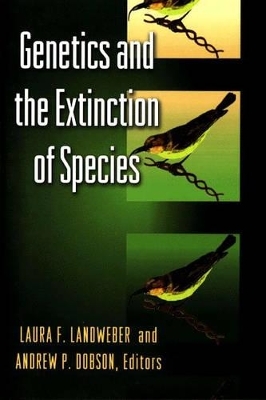
Genetics and the Extinction of Species
Princeton University Press (Verlag)
978-0-691-00971-1 (ISBN)
- Lieferbar (Termin unbekannt)
- Versandkostenfrei innerhalb Deutschlands
- Auch auf Rechnung
- Verfügbarkeit in der Filiale vor Ort prüfen
- Artikel merken
Darwin's Origin of Species and Dobzhansky's Genetics and the Origin of Species have been the cornerstones of modern evolutionary and population genetic theory for the past hundred years, but in the twenty-first century, biologists will face graver problems of extinction. In this collection, a team of leading biologists demonstrates why the burgeoning field of conservation biology must continue to rely on the insights of population genetics if we are to preserve the diversity of living species. Technological and theoretical developments throughout the 1990s have allowed for important new insights into how populations have evolved in response to past selection pressures, while providing a broad new understanding of the genetic structure of natural populations. The authors explore these advances and argue for the applicability of new genetic methods in conservation biology. The volume covers such topics as the reasons for extinctions, the best ways to measure biodiversity, and the benefits and drawbacks of policies like captive breeding.
Genetics and the Extinction of Species is a rich source of information for biologists and policymakers who want to learn more about the host of tools, theories, and approaches available for conserving biodiversity. In addition to the editors, the contributors to the volume are William Amos, Rebecca Cann, Kathryn Rodriguez-Clark, Leslie Douglas, Leonard Freed, Paul Harvey, Kent Holsinger, Russell Lande, and Helen Steers.
Laura F. Landweber is Assistant Professor of Biology at Princeton University and is the co-editor of DNA Based Computers II (AMS) and Evolution as Computation (forthcoming). Andrew P. Dobson is Associate Professor of Biology at Princeton University and is the author of Conservation and Biodiversity.
CONTRIBUTORS vii ILLUSTRATIONS ix PREFACE xi INTRODUCTION: GENETICS AND CONSERVATION BIOLOGY Andrew P. Dobson xiii CHAPTER ONE: Extinction Risks from Anthropogenic, Ecological, and Genetic Factors Russell Lande 1 CHAPTER TWO: Genes, Demes, and Plant Conservation K. E. Holsinger, R. J. Mason-Gamer, and J. Whitton 23 CHAPTER THREE: Genetic Theory and Evidence Supporting Current Practices in Captive Breeding for Conservation Kathryn M. Rodriguez-Clark 47 CHAPTER FOUR: Two Problems with the Measurement of Genetic Diversity and Genetic Distance William Amos 75 CHAPTER FIVE: One Use of Phylogenies for Conservation Biologists: Inferring Population History from Gene Sequences Paul H. Harvey and Helen Steers 101 CHAPTER SIX: Parasites and Conservation of Hawaiian Birds Rebecca L. Cann and Leslie J. Douglas 121 CHAPTER SEVEN: Extinction and Endangerment of Hawaiian Honeycreepers: A Comparative Approach Leonard A. Freed 137 CHAPTER EIGHT: Something Old for Something New: The Future of Ancient DNA in Conservation Biology Laura F. Landweber 163 INDEX 187
| Erscheint lt. Verlag | 21.7.1999 |
|---|---|
| Zusatzinfo | 5 Maps |
| Verlagsort | New Jersey |
| Sprache | englisch |
| Maße | 197 x 254 mm |
| Gewicht | 28 g |
| Themenwelt | Naturwissenschaften ► Biologie ► Evolution |
| Naturwissenschaften ► Biologie ► Genetik / Molekularbiologie | |
| Naturwissenschaften ► Biologie ► Ökologie / Naturschutz | |
| ISBN-10 | 0-691-00971-6 / 0691009716 |
| ISBN-13 | 978-0-691-00971-1 / 9780691009711 |
| Zustand | Neuware |
| Haben Sie eine Frage zum Produkt? |
aus dem Bereich


